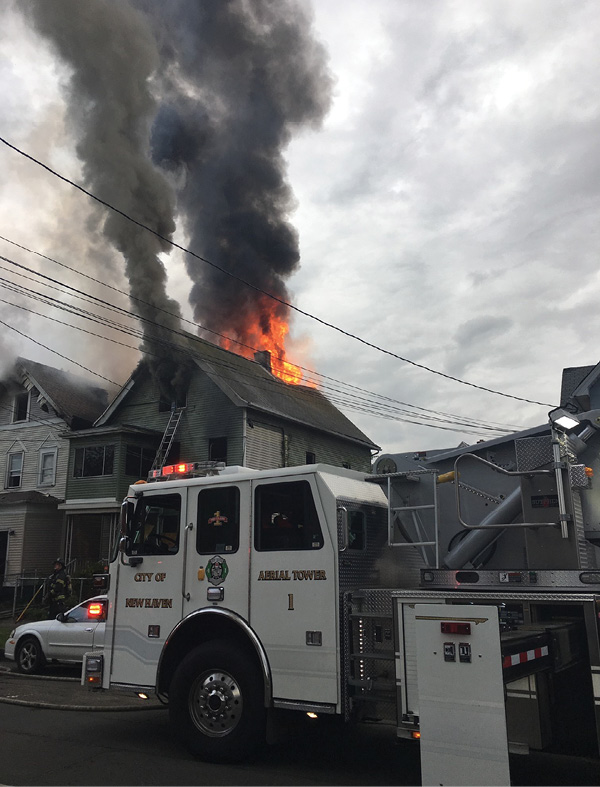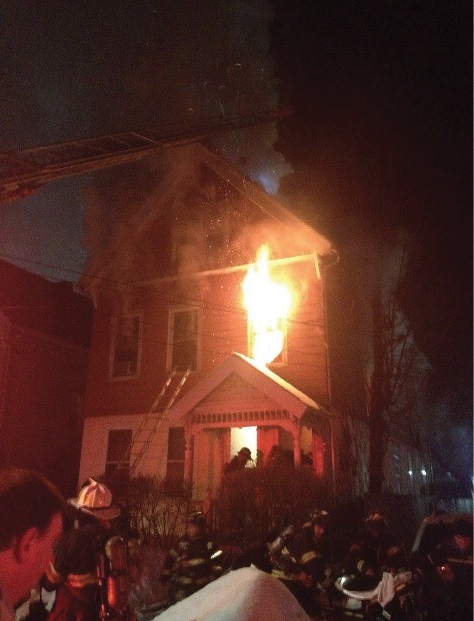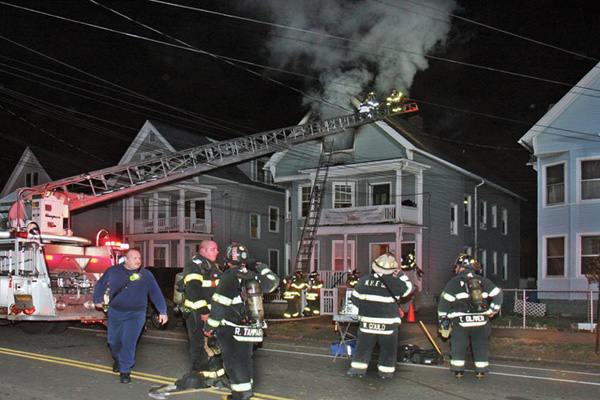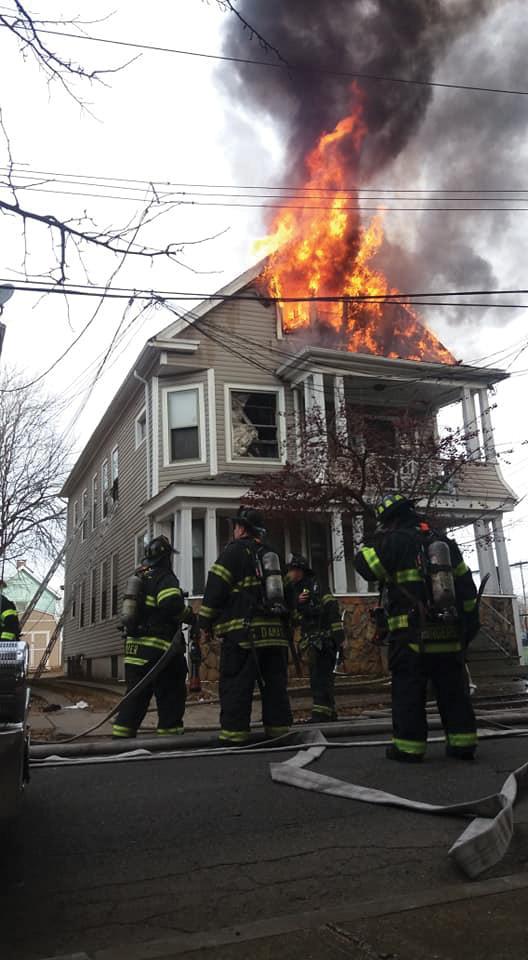
By Jason Rivera
You arrive on scene as the second-due engine with smoke showing from the rear of a large 2½-story, wood-frame, two-family dwelling typical of houses in many moderate sized urban and suburban cities and towns. The first-due company has a line stretched through the front door and is attempting to find the seat of the fire. Based on the age and construction of the building, you determine it is built with balloon-frame construction. The original caller reported fire on the first floor; but based on the smoke condition showing, this fire has extended beyond that. Now the question is, where do I bring my line and how do I get there?

(1) Difficult stretches to the top floor may be facilitated by stretching a dry line. (Photo by Luis Ortegon.)

(2) The line may be charged directly below the smoke stratification line. (Photo by Brad Young.)
We know that basement and lower-floor fires in balloon-frame buildings will rapidly extend up the void spaces in the walls until they hit the roof line and then extend laterally across the roof—that’s basic Firefighter 1 material. We need to get a line to the top floor immediately. With that in mind, now it’s time to do a quick size-up of your hose stretch:
- What size line are you pulling?
- What entrance are you using?
- How large is the floor plan?
- How much line are you going to need?
- Do you need to bring hand tools to open up once you find the seat of the fire?
- What’s your staffing to move this line?
- Where are you getting water to supply this operation?
Hoseline Size
Unless there are some extenuating circumstances, the 1¾-inch is the line of choice for bread-and-butter fires in 2½- and three-story wood-frame buildings. This line should be partnered with a 7⁄8- or 15⁄16-inch smooth bore nozzle or a constant gallonage fog nozzle. These nozzle/hose packages will allow the engine company to flow anywhere between 150 and 185 gallons per minute (gpm) with relatively low nozzle reaction. This critical flow should be able to handle most fires in residential buildings with a normal amount of content and will provide adequate maneuverability to traverse stairwells and move throughout the house and around furniture and other obstructions.
Building Entrances
Knowing how most of these buildings were constructed, there will be a staircase in both the front and the rear. How to access these staircases may or may not be simple. After conducting a brief walk-around (a true 360° may not be possible), the officer needs to quickly determine which entrance to use to access the top floor. Although many of these buildings were constructed in a similar fashion, renovations through the years may have drastically changed the building layout.
As a general rule of thumb, bring the first two lines through the front entrance. The reason for this rule is threefold: (1) Panicked fire victims fleeing the building will generally revert to using the entrance they always use (the front door is the most popular means of egress), and these victims may be unresponsive when found during the hose stretch; (2) the main artery to vertical extension—the interior, unprotected stairwell—will usually be in the vicinity of the front door, so placing your handline there may stop this fire spread; and (3) it enables you to place a hoseline in a position to protect search team members operating on the second floor where the bedrooms may be located.
The second-due engine should also bring the second line into the building, using the front entrance most of the time. This holds true especially when the goal is to get that line to the top floor. However, be aware that not all staircases will lead to the top floor, especially when the third floor had been converted into living space. In this case, you may have to take the line to the rear to access that area.
Floorplan and Length of Hoseline
For this example, let’s assume the order had been given to stretch a line to the front door and proceed to the top floor to cut off any vertical fire extension. The hose stretch starts at the engine. There are several factors when deciding how much line to pull or if your standard preconnect is going to be enough.

(3) Knowing the buildings in your district will assist you in choosing the right entrance to reach the fire floor. (Photo by Doc Johnson.)
First, where did you park the engine? A good engine company will pull at least one or two houses beyond the fire building to allow adequate room for the truck company. Remember, you can always add hose and adjust pump pressure, but you can’t add any length to the aerial device.
Next, determine to what floor you are going. If you are on the first-arriving engine and have fire showing from the basement or lower floor, a solid game plan would be to get the first line in position to attack the main body of fire on the lower floor. Some might say, “But you just said that we need to stop the vertical spread of fire before it reaches the attic.” Yes, this is true. But, it does no good to pass fire on the first floor and stretch to the third floor just in time to have your line burned through as fire takes control of the entire first floor, essentially trapping the first-due engine. Get the first line stretched to the front door. If fire or smoke is indicating the fire is at your floor or below you, charge the line at the door. You never want to enter a building with fire below you without a charged hoseline.
Now, how about that second line, which is the main focus of this article? With the first line operating on the main body of fire on the lower floor, someone has to get a line to the top floor to cut off the fire’s vertical spread. This would be the job of the second-arriving engine and any additional personnel arriving on scene. In some circumstances, the first-due engine may have to reposition its line once the main body of fire is knocked down on the lower floors. Is that going to be physically exhausting? Absolutely, but sometimes in this line of work we have to do whatever we need to do to guarantee a successful outcome. Many departments don’t have the luxury of adequate personnel, and mutual aid may be coming from a distance.
In a perfect world, the second line would be stretched almost simultaneously with the first one; but since none of us live in that world, we need to make sure that adequate personnel are on the way or, better yet, on scene to make it happen. For these reasons, we must call for personnel early and often. Ensure you have adequate, capable personnel to complete all tasks.
How much line do you need inside the building? A good rule of thumb is to estimate one 50-foot length of hose for every floor you ascend. For this example, you are going to the third floor, which will require two lengths of hose, one from floor 1 to floor 2 and one from floor 2 to floor 3. You also need to consider the size of the floorplan, so add an extra 50 feet of hose to reach the area of the fire.
Tools and Personnel
If your department doesn’t have the staffing to team up two companies or have a truck company arriving with the first-due engine, the firefighters from the initial-arriving engine company will have to pull double duty—stretch a line and bring tools (irons, hooks) to the fire building. Stretching a line inside a building is a personnel-intensive and expeditious activity, so leaving the tools in a known location, possibly right outside the front door, may be necessary. This will speed up the stretch and allow the tools to be quickly retrieved when the time comes. As for personnel positioning, spread out your people; do not let them bunch up. Having a firefighter on every corner may not be realistic for most departments, so the members on the line are going to have to hustle.
Water Supply
Once you have a second line operating, you may be flowing upward of 400 gpm. That’s a lot of water, especially if you are operating off a 500-gallon onboard water tank. It’s time to establish a positive water supply. If you’re lucky enough to work in a city with hydrants every 500 feet, this shouldn’t be a big deal; but, what if there isn’t a hydrant anywhere near you?
One tactic that I have seen used with great success is to bury the first tender/tanker in the driveway with the first engine. Yes, that will take it out of the loop for water shuttle operations, but if you aren’t getting this fire with the first 3,000 to 4,000 gallons, you’re going have plenty of time to set up a proper water shuttle. Get in there, and hit it hard right off the bat. The majority of the time, with properly placed and staffed handlines, you will come out on top.
The Case for Stretching Dry
Some departments allow their members to stretch dry into a structure fire on an upper floor; others do not. There are positives and negatives to both. In my opinion, the benefits of the dry stretch far outweigh the drawbacks. Let’s say we charge the line at the door. The stretch will be greatly delayed, allowing the fire to grow rapidly, possibly outflanking the crew once they get their line into position. Many houses are cluttered with furniture, appliances, and other general debris around which it is very difficult to negotiate yourself and your line. Keeping the line dry with a travel section (50 feet) on your shoulder will allow the company to more easily traverse these obstacles and get the line in place quickly and efficiently.
The weight of a dry 1¾-inch line ranges from 15 to 25 pounds per 50 feet, depending on the manufacturer, vs. a charged line, which holds approximately 6.2 gallons of water, adding an additional 51 pounds to the line. That’s just for 50 feet! This additional weight will tire the members, deplete their self-contained breathing apparatus more quickly, and have them exhausted by the time they reach the seat of the fire (where the real work begins).
How about unexpected challenges like large appliances in living spaces, tight staircases, or doors that open only partially? Maneuvering a dry line in and around these obstructions will be far easier than doing so with a charged line. A quick note regarding doors: Any swinging door needs to get chocked in the open position to prevent it from closing over the uncharged line.

(4) Reading smoke and fire conditions on arrival will aid in line stretching decision making. (Photo by Trell Simmons.)
Charging the Line
The question now is, where do you charge the line? A couple of rules still hold true. If you believe you are entering a building where the fire is in the basement, you need to charge the line at the front door. Why? Because basements typically lack any sort of fire protection or resistance and also have high fuel loads. You would not want to place yourself directly over this situation without the protection of a charged handline.
If the fire is not in the basement and you need to get to an upper floor, advance the line dry until you are right below the level where the smoke has stratified. At this point, you can mask up in a safe area, gather any tools needed, call for water, and prepare for the firefight. If additional personnel have not arrived on scene, you may choose to send someone to grab some hooks to open up walls and ceilings since that is where you are likely to find fire on an upper floor.
Where Do You Open Up?
When you arrive on the top floor, you will likely be met with a light to moderate smoke condition and little to no heat if the fire is still contained in the voids. A search of the floor may yield a few clues to where the fire is. Clues will include smoke coming from the baseboard, areas with higher heat, and heavier smoke conditions. Listen to radio transmissions from other companies; they may give geographic clues as to where the fire is. Also, have members stick their heads out of an open window to orient themselves as to where they are in the building and possibly witness smoke and fire locations. If the open windows may adversely affect fire growth, close them before proceeding.
Once you narrow down the location, get the members with hooks to the front of the line and have the nozzle firefighter prepare to flow water when directed. These fires are usually hidden behind knee walls found running in pipe chases or behind walls with cabinets or furniture in the way. When you sink the working end of the hook into the wall, fire may shoot out. Do not immediately open the line. Allow the members to open up a significant sized hole and some inspection holes to see where the fire is traveling. The purpose of getting this line to the top floor is to cut off the rapid spread of fire vertically and horizontally. Open up until you find no fire present and then work your way back. Don’t let the fire outflank you, or you may burn the roof right off the house. If more personnel and equipment are needed, call for them! An aggressive, hardworking push will likely bring the fire under control quickly.
At structure fires where the fire has entered the void spaces, it will extend rapidly, causing extensive damage and putting firefighters’ lives in danger. The best way to combat this is for the engine company to make a fast, aggressive stretch to the top floor. This is best accomplished by stretching dry as far as is safely possible. Fire conditions may prevent you from using this tactic, but always consider its use. A dry hoseline weighs significantly less, is easier to maneuver around objects, and requires fewer personnel to move. The name of the game to be successful is fast, adequate water on the fire. The longer it takes to get the hoseline where it needs to go, the greater the fire will grow in intensity and size. The only way to get better at this skill is to get out there and practice. Reading articles is the first step; now get out there and do it!
Jason Rivera is a 25-year veteran of the fire service and has served in career and volunteer departments. He retired as the captain of Rescue 1 for the Stamford (CT) Fire Department and is a firefighter for the New Haven (CT) Fire Department, where he is assigned to Squad Co. 2. He is assistant chief for the Newtown (CT) Hook and Ladder Fire Company. He is a Pro-Board certified fire service instructor level 3 and has presented “Overcoming Common Engine Company Mistakes and Fireground Problems” at FDIC International 2017 and 2018. He was the recipient of the 2016 Ray Downey Courage and Valor Award. He is a rescue specialist with FEMA US&R MA-TF1.
RELATED
Firefighter Jason Rivera Receives 2016 Ray Downey Courage and Valor Award

